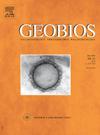Borophagine canids of the Monarch Mill Formation (Middle Miocene), Nevada, U.S.A.
IF 1.6
4区 地球科学
Q2 PALEONTOLOGY
引用次数: 0
Abstract
The non-marine Middle Miocene Monarch Mill Formation (Nevada, U.S.A.) outcrops in the Middlegate Basin and preserves fossil mammals that lived during the establishment of the present-day basin and range topography in central Nevada. The Monarch Mill Formation and its mammal fauna overlie the Middlegate Formation and its flora, and together the biota provides an informative window into ecosystem composition at the geographic crossroads between the Great Plains and the coastal regions of North America during the Middle Miocene. Here we report on previously undescribed and/or unfigured canids from the Monarch Mill Formation. To the previously known borophagine Tomarctus brevirostris and the fox-like canine Leptocyon we add two borophagine genera to the Eastgate Local Fauna of the Monarch Mill Formation. Specimens of the hypocarnivores Paracynarctus and Cynarctus are described and provide an enhanced understanding of the Middlegate Basin canid assemblage, now comprising at least four genera. Together with floral evidence, this canid assemblage is indicative of mesocarnivore-sustaining vegetation and locally limited open environments, with no hypercarnivorous canid occurrences. Rapid regional subsidence was an overarching factor in the shift towards present-day hyper- and meso-carnivore dominated canid assemblages in the Basin and Range Province, and the appearance of hypercarnivores in post-Barstovian times may reflect contemporaneous regional topographic shifts in the Great Basin at large.
美国内华达帝王磨坊组(中新世中期)的犬科动物
非海相中中新世帝王磨坊组(美国内华达州)在米德尔盖特盆地露头,并保存了在内华达中部盆地和山脉地形建立期间生活的哺乳动物化石。君主磨坊组和它的哺乳动物群覆盖在米德尔盖特组和它的植物群上,这些生物群一起提供了一个信息窗口,可以了解中新世中期大平原和北美沿海地区地理十字路口的生态系统组成。在这里,我们报告了以前未描述和/或未计算的犬科动物从君主磨坊组。在先前已知的borophagine Tomarctus brevirostris和fox-like canine lepptocyon的基础上,我们将两个borophagine属添加到Monarch Mill Formation的Eastgate Local Fauna中。描述了准食肉动物Paracynarctus和Cynarctus的标本,并提供了对米德尔盖特盆地犬科动物组合的更好理解,现在至少包括四个属。结合植物的证据,这一犬科动物组合表明了中肉食性植被和局部有限的开放环境,没有超肉食性犬科动物的出现。快速的区域沉降是盆地和山脉省向现今超食肉动物和中食肉动物为主的犬科动物组合转变的主要因素,后巴斯托夫时代超食肉动物的出现可能反映了大盆地同期区域地形的变化。
本文章由计算机程序翻译,如有差异,请以英文原文为准。
求助全文
约1分钟内获得全文
求助全文
来源期刊

Geobios
地学-古生物学
CiteScore
3.30
自引率
6.20%
发文量
28
审稿时长
6-12 weeks
期刊介绍:
Geobios publishes bimonthly in English original peer-reviewed articles of international interest in any area of paleontology, paleobiology, paleoecology, paleobiogeography, (bio)stratigraphy and biogeochemistry. All taxonomic groups are treated, including microfossils, invertebrates, plants, vertebrates and ichnofossils.
Geobios welcomes descriptive papers based on original material (e.g. large Systematic Paleontology works), as well as more analytically and/or methodologically oriented papers, provided they offer strong and significant biochronological/biostratigraphical, paleobiogeographical, paleobiological and/or phylogenetic new insights and perspectices. A high priority level is given to synchronic and/or diachronic studies based on multi- or inter-disciplinary approaches mixing various fields of Earth and Life Sciences. Works based on extant data are also considered, provided they offer significant insights into geological-time studies.
 求助内容:
求助内容: 应助结果提醒方式:
应助结果提醒方式:


